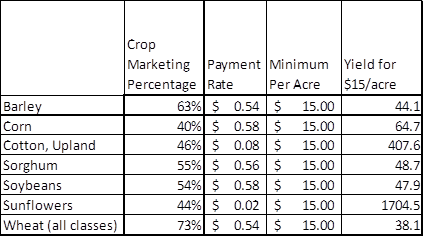Reading Time: 3 minutesIt has been the talk of the Ag sector throughout the last few weeks: expectations for another round of Coronavirus Food Assistance Program (CFAP) for producers affected by the COVID-19 pandemic.
President Trump gave official confirmation in a campaign rally speech in Wisconsin on September 17. While the original CFAP1 program fell short of payment estimates and frustrated many producers with less help than expected, CFAP2 was officially released by the USDA (on September 18) – just one week after the CFAP1 application deadline.
This new round of payments will have $14 billion available, and will be provided to producers who have been affected by marketing disruptions and extra marketing costs due to COVID-19.
CFAP2: 3 Payment Commodity Categories
 Any APH above the yield in this chart will result in a payment over $15
Broiler and egg eligible producers will be paid based on 75% of their 2019 production Broilers will have the 75% multiplied by $1.01 per bird. Shell eggs will be paid $0.05/dozen, Liquid Eggs- $0.04/lb, Dried Eggs- $0.14/lb, and Frozen Eggs- $0.05/lb; all multiplied by 75% of 2019 Production.
Cow Milk dairy producers will be paid $1.20 per hundredweight based on:
Any APH above the yield in this chart will result in a payment over $15
Broiler and egg eligible producers will be paid based on 75% of their 2019 production Broilers will have the 75% multiplied by $1.01 per bird. Shell eggs will be paid $0.05/dozen, Liquid Eggs- $0.04/lb, Dried Eggs- $0.14/lb, and Frozen Eggs- $0.05/lb; all multiplied by 75% of 2019 Production.
Cow Milk dairy producers will be paid $1.20 per hundredweight based on:
- Price Trigger Commodities – Eligible commodities that fall into this category saw a measurable, 5% price decline over a period of time identified by USDA. Based on 2020 acres.
- Flat-rate Commodities – Eligible commodities did not have a 5% price decline of the specified period or data was insufficient to calculate. Based on 2020 acres.
- Sales Commodities – Based on 2019 sales and calculated in five payment gradients.
- $15/acre
- Nationwide crop marketing percentage, multiplied by a crop-specific payment rate, multiplied by the producers weighted 2020 Actual Production History (APH) yield
 Any APH above the yield in this chart will result in a payment over $15
Broiler and egg eligible producers will be paid based on 75% of their 2019 production Broilers will have the 75% multiplied by $1.01 per bird. Shell eggs will be paid $0.05/dozen, Liquid Eggs- $0.04/lb, Dried Eggs- $0.14/lb, and Frozen Eggs- $0.05/lb; all multiplied by 75% of 2019 Production.
Cow Milk dairy producers will be paid $1.20 per hundredweight based on:
Any APH above the yield in this chart will result in a payment over $15
Broiler and egg eligible producers will be paid based on 75% of their 2019 production Broilers will have the 75% multiplied by $1.01 per bird. Shell eggs will be paid $0.05/dozen, Liquid Eggs- $0.04/lb, Dried Eggs- $0.14/lb, and Frozen Eggs- $0.05/lb; all multiplied by 75% of 2019 Production.
Cow Milk dairy producers will be paid $1.20 per hundredweight based on:
- Actual production from April 1 to August 31, 2020 and
- Average daily production from April 1 to August 31, 2020, multiplied by 122
- $55/head for beef cattle (excluding breeding stock)
- $23/head for hogs and pigs (excluding breeding stock)
- $27/head for lambs and sheep (excluding breeding stock)
- Wool
- Goat Milk
- Tobacco
- Mohair
- Eligible Fruits
- Vegetables
- Horticulture
- Tree nuts
- Honey
- Maple Syrup
- Nursery
- Cut Flowers and Greenery
- Cactus and Christmas Trees
- Aquaculture
- Specialty Livestock: alpacas, bison, buffalo, beefalo, deer, ducks, elk, emus, geese, goats, guinea pigs, llamas, mink (including pelts), mohair, ostrich, pheasants, quail, rabbits, reindeer, and turkey
- 10.6% of sells between $0-$49,999
- 9.9% of sells between $50,000-$99,999
- 9.7% of sells between $100,000- $499,999
- 9.0% of sells between $500,000- $999,999
- 8.8% of sells over $1 million








